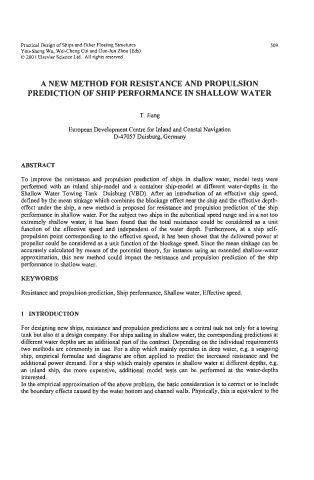Page 534 - Practical Design Ships and Floating Structures
P. 534
Practical Design of Ships and Other FIoating Structures 509
You-Sheng Wu, Wei-Cheng Cui and Guo-Jun Zhou (Eds)
0 2001 Elsevier Science Ltd. All rights reserved
A NEW METHOD FOR RESISTANCE AND PROPULSION
PREDICTION OF SHIP PERFORMANCE IN SHALLOW WATER
T. Jiang
European Development Centre for Inland and Coastal Navigation
D-47057 Duisburg, Germany
ABSTRACT
To improve the resistance and propulsion prediction of ships in shallow water, model tests were
performed with an inland ship-model and a container ship-model at different water-depths in the
Shallow Water Towing Tank Duisburg (VBD). After an introduction of an effective ship speed,
defined by the mean sinkage which combines the blockage effect near the ship and the effective depth-
effect under the ship, a new method is proposed for resistance and propulsion prediction of the ship
performance in shallow water. For the subject two ships in the subcritical speed range and in a not too
extremely shallow water, it has been found that the total resistance could be considered as a unit
hction of the effective speed and independent of the water depth. Furthermore, at a ship self-
propulsion point corresponding to the effective speed, it has been shown that the delivered power at
propeller could be considered as a unit function of the blockage speed. Since the mean sinkage can be
accurately calculated by means of the potential theory, for instance using an extended shallow-water
approximation, this new method could impact the resistance and propulsion prediction of the ship
performance in shallow water.
KEYWORDS
Resistance and propulsion prediction, Ship performance, Shallow water, Effective speed.
1 INTRODUCTION
For designing new ships, resistance and propulsion predictions are a central task not only for a towing
tank but also at a design company. For ships sailing in shallow water, the corresponding predictions at
different water depths are an additional part of the contract. Depending on the individual requirements
two methods are commonly in use. For a ship which mainly operates in deep water, e.g. a seagoing
ship, empirical formulae and diagrams are often applied to predict the increased resistance and the
additional power demand. For a ship which mainly operates in shallow water at different depths, e.g.
an inland ship, the more expensive, additional model tests can be performed at the water-depths
interested.
In the empirical approximation of the above problem, the basic consideration is to correct or to include
the boundary effects caused by the water bottom and channel walls. Physically, this is equivalent to the

